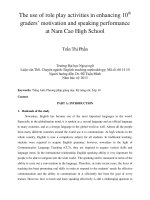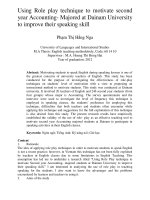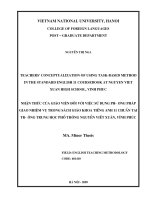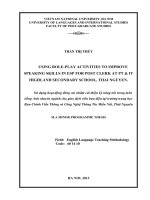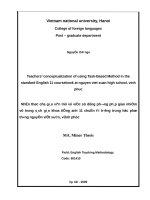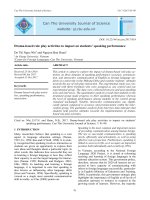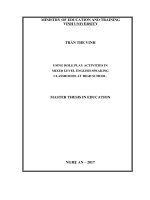USING ROLE PLAY ACTIVITIES IN MIXED LEVEL ENGLISH SPEAKING CLASSROOMS AT HIGH SCHOOL
Bạn đang xem bản rút gọn của tài liệu. Xem và tải ngay bản đầy đủ của tài liệu tại đây (580.85 KB, 88 trang )
MINISTRY OF EDUCATION AND TRAINING
VINH UNIVERSITY
TRẦN THÉ VINH
USING ROLE PLAY ACTIVITIES IN
MIXED LEVEL ENGLISH SPEAKING
CLASSROOMS AT HIGH SCHOOL.
MASTER THESIS IN EDUCATION
NGHỆ AN - 2017
TRẦN THẾ VINH
MINISTRY OF EDUCATION AND TRAINING
VINH UNIVERSITY
USING ROLE PLAY ACTIVITIES IN
MIXED LEVEL ENGLISH SPEAKING
CLASSROOMS AT HIGH SCHOOL.
Field: Theory and Methodology of English Language Teaching
Code: 60.14.61.11
MASTER THESIS IN EDUCATION
Supervisor: TRAN BA TIEN, Ph. D.
NGHỆ AN - 2017
STATEMENT OF AUTHORSHIP
I hereby certify that I am the sole author of this study. This study is submitted in partial fulfillment for the Master
degree of Theory and Methodology of English Language Teaching at Vinh University and has not been submitted
elsewhere in any other form for the fulfillment of any other degree or qualification.
Signature
Tran The Vinh
ACKNOWLEDGEMENTS
I really realize that this thesis project is finished with the help of many people around me. Therefore, this
opportunity I would like to thank people who have given their ideas, times, and everything to me during the
writing of this thesis.
First, I would like to express my special gratitude to my supervisor, Dr. Tran Ba Tien for his invaluable time,
guidance, insightful comments, patience, encouragement, and suggestion in guiding me during the process of
writing this thesis.
Second, I am grateful to the teachers of English, who answered my questionnaire and interviewing questions and
1
allowed me to carry out my observation and the students at Nguyen Cong Tru High school for what they have
done to help me finish the thesis.
Last but not least, I would like to express my special thanks to my family, my friend and so many others who have
given me constant support and love during the completion of the study.
Vinh, May 2017
ABSTRACT
Speaking is one of the most challenging and troublesome skills in our schools and in mixed level classrooms.
Because of the skill difficulties, our pupils find it difficult to master all the aspects of speaking and use them
appropriately in different social contexts. Therefore, they do not perform acceptable tasks. It is our belief that the
problem is the result of lack of efficient strategies. The present study aimed at shedding the light on
communication in classrooms; acting role-play as a good model for bringing real-life situations into mixed level
classrooms and promoting students self-confidence through expressing their ideas during the practice of role plays
activities. Accordingly, we believe that using role-play activities in the classrooms make pupils of high school feel
interesting to speak English and communicate effectively in different social situations. In attempting to raise the
teachers’ and pupils’ awareness about role play, we have directed the questionnaires, observations, interviews to
11th graders’ high school and all the teachers of English to investigate their attitudes towards using role-play
technique.
The results from the analysis of those have confirmed the research hypothesis and have shown that teachers and
learners hold favorable attitudes towards using role play techniques, the advantages and disadvantages, how to
2
optimise it as well mentioned. Thus, we recommend the using of different techniques such as role play activities
in teaching speaking to develop pupils’ speaking skill.
STATEMENT OF AUTHORSHIP..................................................................................................i
ACKNOWLEDGEMENTS..............................................................................................................i
ABSTRACT......................................................................................................................................iii
TABLES OF CONTENT.................................................................................................................iv
LIST OF TABLES...........................................................................................................................vii
LIST OF FIGURES.......................................................................................................................viii
CHAPTER ONE: INTRODUCTION............................................................................................1
1.1. Motivation for the study............................................................................................1
1.2. Aims of the study.......................................................................................................3
1.3. Research methods......................................................................................................3
1.4.
1.5.
Scope of the study....................................................................................................3
Significance of the study..........................................................................................3
1.6..................................................................................................................................... Identification of the
Problem............................................................................................................................ 4
1.7. Organization of the study...........................................................................................5
CHAPTER TWO: LITERATURE REVIEW...............................................................................6
2.1. The Nature of Speaking.............................................................................................6
2.2. Speaking Skills and the Aspects of Speaking............................................................7
2.3. Teaching Speaking....................................................................................................9
3
2.3.1. The Roles of the Teachers and the Students in the EFL of Speaking.....................9
2.4. Principles of Teaching Speaking.............................................................................10
2.4.1. The teachers should aware of the differences between second language and
foreign language learning contexts..................................................................................10
2.4.2. The teachers should give students practice with both fluency and accuracy.........11
2.4.3. The teachers should provide opportunities for students to talk by using group
work or pair work and limiting teacher talk.....................................................................11
2.4.4.................................................................................................................................. The teacher should plan
speaking tasks that involves negotiation for meaning.......................................................11
2.4.5. The teacher should design classroom activities that guided and practiced in both
transactional and interpersonal function..........................................................................11
2.5.
Criteria for Speaking Tasks..................................................................................12
2.6. Classroom Speaking Activities................................................................................13
2.7. Problems in Teaching Speaking...............................................................................15
2.8. Assessing Speaking.................................................................................................16
4
2.9. Role Play Activities.................................................................................................17
2.9.1. What is role-play?.................................................................................................17
2.9.2. Definition of role-play..........................................................................................18
2.9.3. Types and procedures of Role play......................................................................19
2.9.3.1 Scripted Role play..............................................................................................19
2.9.3.2 Unscripted Role play..........................................................................................20
2.10. Role-play and simulation.......................................................................................20
2.11. The organisation of a role-play activity................................................................21
2.12. Advantages of role-play........................................................................................23
2.13. Pair work and group work as patterns of classroom interaction in role-play.........26
2.14. The teacher’s roles in role-play.............................................................................27
2.15. Mixed ability classrooms......................................................................................28
2.15.1. Definition of a mixed ability class......................................................................29
2.15.2. Mixed Ability Teaching......................................................................................29
2.16. Some Problems in the Mixed Ability Classes........................................................30
2.16.1. Materials............................................................................................................. 31
2.16.2. Participation.......................................................................................................31
2.16.3. Interests..............................................................................................................31
CHAPTER THREE: METHODOLOGY....................................................................................35
3.1. Research questions..................................................................................................35
3.1.1. What attitude do teachers and students have toward learning English speaking
and role-play activities ?..................................................................................................35
3.1.2. What are the advantages and disadvantages of using role-play to enhance 11th
graders’ English speaking skill?.......................................................................................35
3.1.3. How can role-play activities be optimized in a mixed level English class?..........35
3.2. Research participants...............................................................................................35
3.2.1. The researcher......................................................................................................35
3.2.2. The subjects..........................................................................................................35
3.2.3. Research procedure..............................................................................................35
3.2.4. Data collection instruments..................................................................................36
3.3. Survey questionnaires..............................................................................................36
3.4. Observations............................................................................................................36
3.5. Interview.................................................................................................................37
CHAPTER FOUR: RESULTS AND DISCUSSION..................................................................39
LIST OF TABLES
4.1. Results analysis.......................................................................................................39
4.1.1. Questionnaires.....................................................................................................39
4.1.1.1. Questionnaire for students.................................................................................39
4.1.1.2. Teacher questionnaire........................................................................................52
4.1.2.
Interviewing.......................................................................................................58
4.1.2.1. Teachers' interviewing.......................................................................................58
4.1.2.2. Students' interviewing........................................................................................60
4.1.3. Observation..........................................................................................................57
4.1.3.1. The first observed class......................................................................................57
4.1.3.2. The second observed class.................................................................................58
4.1.3.3. The third observed class....................................................................................59
4.1.3.4. The fourth observed class..................................................................................60
4. 2. Discussion..............................................................................................................61
4.2.1. Research question 1: What attitude do teachers and students have toward
learning speaking English and role-play activities?.........................................................62
4.2.1.1. Students' attitude toward learning speaking English..........................................62
4.2.1.2. Students' attitude toward role-play activities.....................................................62
4.2.1.3 Teachers attitude toward role-play activities........................................................63
4.2.2.
Research question 2: What are the advantages and disadvantages of using role-
play to enhance 11th graders’ English speaking skill?.....................................................63
4.2.2.1. The effectiveness of applying role-play.............................................................63
4.2.2.2. The difficulties of applying role-play.................................................................64
4.2.3. Research question 3: How can role-play activities be optimized in a mixed level
English classrooms?.........................................................................................................64
4.2.3.1. The advice for teachers......................................................................................64
4.2.3.2. The advice for students......................................................................................65
CHAPTER FIVE: CONCLUSION...............................................................................................66
1.1. Overview of the thesis..............................................................................................66
1.2. Limitations of the thesis...........................................................................................67
1.3. Suggestions for further research...............................................................................67
REFERENCES....................................................................................................................................i
APPENDICES I................................................................................................................ iv
APPENDICES II..............................................................................................................vi
OBSERVATION SHEET..................................................................................................ix
Tables of students'questionnaire analysis
Table 1. Students' attitude towards speaking English.....................................................39
Table 2. Students' thought about learning speaking........................................................40
Table 3. Students' speaking ability.................................................................................41
Table 4. Pupils' thinking about Role play.......................................................................41
Table 5. The frequencies of teachers' applying role - play..............................................42
Table 6. Students' thought about the way that teachers apply role-play.........................43
Table 7. How does your teacher act during the plays performance ?.............................43
Table 8. Students' thought about role-play activities......................................................44
Table 9. Students' opinion about the profit of participating in role-play........................45
Table 10. Students' benefits when participating in role-play activities............................46
Table 11. It gives an opportunity to express emotions freely..........................................46
Table 12. Students' advantages when participating in role-play activities.......................47
Table 13. Student's difficulties when participating in role-play activities.......................48
Table.14. The students' concentration on the topics of role-play activities.....................48
Table 15. Students' opinions about their teacher's instruction.........................................49
Table 16. Pupils satisfaction with the level of speaking..................................................50
Table 17. When performing role plays in your class , do you prefer ?............................50
Table 18. The feedback after role play helps to improve further.....................................51
Table 19. The improvement of students' speaking ability...............................................52
Tables of teachers'questionnaire analysis
Table 1:Teachers' opinion about their students' attitude about learning speaking..............49
Table 2: Teachers" opinion about their students' speaking ability.....................................50
Table 3: Are you sastified with your students level in speaking?...................................51
Table 4: It is an easy method to communicate with others................................................51
Table 5: Teachers have applied role-play activities........................................................51
Table 6: Teachers' difficulties when applying role-play activities...............................52
Table 7: The usefulness of role-play activities............................................................53
Table 8: Teachers' opinion about whether applying role-play in mixed level classrooms
is difficult or not..........................................................................................................54
Table 9: Teachers’ opinion about applying role-play in mixed level english speaking
classrooms................................................................................................................... 54
Table 10: Teachers' opinion about their students' speaking ability improvement------55
LIST OF FIGURES
Figures of students'questionnaire analysis
Figure 2.0.1. Advantages of Role play
----------------------------------------------------------------------------------------------------------------------------------------------------
Figure 2.0.2. Advantages of Role plays
-------------------------------------------------------------------------------------------------------------------------------------------------
Figure .l.Students' attitude towards speaking English
26
----------------------------------------------------------------------------------------------------
39
-----------------------------------------------------------------------------------------------------
40
--------------------------------------------------------------------------------------------------------------------------------------------------------
41
Figure .2. Students' thought about learning speaking
Figure .3. Students' speaking ability
25
Figure .4. Pupils' thinking about Role play
-----------------------------------------------------------------------------------------------------------------------------------
Figure .5. The frequencies of teachers' applying role - play
----------------------------------------------------------------------------------
Figure 0.6. Students' thought about the way that teachers apply role-play
42
--------------------------------------
43
-------------------------------------------------
43
--------------------------------------------------------------------------------------------------
44
Figure .7. How does your teacher act during the plays performance ?
Figure .8. Students' thought about role-play activities
41
Figure .9. Students' opinion about the profit ofparticipating in role-play
------------------------------------------
45
----------------------------------------------
46
----------------------------------------------------------------------------
46
Figure .10. Students' benefits when participating in role-play activities
Figure .11. It gives an opportunity to express emotions freely
Figure .12. Students' advantages when participating in role-play activities
Figure .13. Student's difficulties when participating in role-play activities
-----------------------------------
47
-------------------------------------
48
Figure .14. The students' concentration on the topics of role-play activities
---------------------------------
48
----------------------------------------------------------------------
49
------------------------------------------------------------------------------------------
50
Figure .15. Students' opinions about their teacher's instruction
Figure .16. Pupils satisfaction with the level of speaking
Figure .17. When performing role plays in your class, do you prefer ?
-------------------------------------------------
50
----------------------------------------------------------------
51
--------------------------------------------------------------------------------------
52
Figure .18. The feedback after role play helps to improve further
Figure .19. The improvement of students' speaking ability
Figures ofteachers'questionnaire analysis
Figure . 1 :Teachers opinion about their students' attitude about learning speaking
-----------
49
----------------------------------------------------------
50
-----------------------------------------------------------------
51
---------------------------------------------------------------------------------
51
-------------------------------------------------------------------------------------------------------
51
'
Figure .2: Teachers " opinion about their students' speaking ability
Figure .3: Are you sastified with your students level in speaking?
Figure .4: It is an easy method to communicate with others.
Figure .5: Teachers have applied role-play activities
Figure .6: Teachers' difficulties when applying role-play activities
Figure . 7: The usefulness of role-play activities
--------------------------------------------------------------
52
---------------------------------------------------------------------------------------------------------------------
53
Figure .8: Teachers' opinion about whether applying role-play in mixed level english
speaking classrooms is difficult or not
------------------------------------------------------
54
Figure .9: Teachers’ opinion about applying role-play in mixed level english speaking
classrooms
-------------------------------------------------------------------------------------------------------------------------------------------------------------------------------------------------------------------------------------
Figure .10: Teachers' opinion about their students' speaking ability improvement
-----------------
54
55
Chapter 1
INTRODUCTION
This chapter introduces some very first parts of the thesis; there are seven parts in
this chapter: (1) rationale for the study; (2) aims of the study; (3) research methods;
(4) scope of the study; (5) significance of the study; (6) identification of the problem
and (7) organization of the study.
1.1. Rationale for the study
English becomes the most essential language in the world. Almost all the people
from many different countries around the world use it to communicate. The area of
English has always become a special interest. It’s because of the importance of
English in any scope of our lives.
Julian Edge said: “Since British trade, followed by colonial and imperial
expansion, English spread around the world. Then the military and economic
dominance of the United States of America has confirmed English as the
international language of present historical period. As a consequence, English serves
for many times many more people as a barrier between themselves and those some
fields of interest, many people in their own countries will not be able to become
doctors, for example if they cannot learn enough English.”
In the international relationship, English speaking ability is very important to be
able to participate in the wider world of work. The speaking skill is measured in
terms of the ability to carry out a conversation in the language. This reality makes
teachers and parents think that speaking ability should be mastered by their students
and children.
Based on the reasons above, in recent years, English language teaching has
focused on teach the English language rather than teach about the English language.
The emphasis is not only on linguistic competence of the language learners but also
on the development of their communicative ability. In order to develop the learners'
communicative ability, the teacher needs to create a scenario to teach the target
language in a vibrant, active and interesting manner.
In learning speaking skill, the students often find some problems. The
1
problem frequently found is that their native language causes them difficult to
use the foreign language. Other reason is because of motivation lack to practice the
second language in daily conversation. They are also too shy and afraid to take part
in the conversation. Many factors can cause the problem of the students’ speaking
skills namely the students’ interest, the material, and the media among others
including the technique in teaching English. Many techniques can be applied
including role play because many research findings say that this technique is
effective to use in teaching speaking.
In Vietnam, especially in many countryside schools, speaking skill usually is
neglected. Teachers spend almost all class time for teaching grammar; therefore,
students lack the chances to practice speaking (Nguyen Quoc Hung, M.A). In
others case, speaking classes are the time for learning by heart dialogs or
practicing repetition of drills. Students cannot cavalier this drills in their real
conversations. The result is more and more students lose their belief in their ability
of speaking English.
Role play is very important in teaching speaking because it gives students an
opportunity to practice communicating in different social contexts and in different
social roles. In addition, it also allows students to be creative and to put themselves
in another person’s place for a while. According to Stephen D. Hattings based on his
observation in the conversation class, the role play would seem to be the ideal
activity in which students could use their English creatively and it aims to stimulate
a conversation situation in which students might find themselves and give them an
opportunity to practice and develop their communication skill.
How to use role-play in speaking skills for the mixed level classrooms suitably and
usefully to help students create the more effectiveness in oral skills, take
advantages of developing this activity and overcome difficulties is the target. Roleplay activity is one of the best ways that can help teachers carry out this. Since
teachers apply role- play activities in class, students are activated because they are
set into an interesting speaking environment.
For these reasons, the writer is interested in analyzing the use of role play in
teaching speaking for the students of the eleventh grade in Nguyen Cong Tru High
2
school with the thesis name “Using role play activities in mixed level english
speaking classrooms at High school He also wants to know the advantages and the
problems encountered by learners and teachers in using it.
1.2. Aims of the study
The thesis aims to identify how to clarify the problem in the use of role play
activities in teaching speaking in the mixed level classrooms, the basic concept of
speaking, some types and procedures in using role play. The thesis, in addition, aims
to find out the effect of using role-play in speaking classes. Also, it is intended to
find out difficulties from using role-play activities so that the researcher can suggest
some solutions to these difficulties.
1.3. Research methods
During studying process, there are three research methods which are going to collect
valuable data and information: questionnaires, observation and interview. Firstly, the
questionnaires are employed. In order to collect the data, two types of questionnaires
are designed: one in English and the other in Vietnamese. The English questionnaire
is delivered to four teachers, who teach in grade 11 and the Vietnamese one is used
for students. Collected data will be analyzed to realize how role-play is applied and
the effect of using role-play in class. Next, personal observations are also carried out
in some classes, which role-play is applied to observe teachers and students' roleplay activities. Furthermore, interview is use to find out teachers and students
difficulties from using role-play.
1.4. Scope of the study
The scope of study is about using role play activities in mixed level english speaking
classrooms at High school.
1.5. Significance of the study
Hopefully, the findings of the study may make a contribution to speaking English
for student toward using role-play activities. What are the advantages and
disadvantages when teacher applying role-play are found in this thesis. Furthermore,
not only does it help to find out the difficulties when using role- play but also some
suggestions will be given to help teachers and students overcome these difficulties.
1.6. Identification of the Problem
3
Speaking is extremely crucial to be learned by students to develop their skills in
studying English. To share and to express the ideas is its functions. In the real
classroom situations when teaching, I find that teaching speaking skill has many
shortcomings.
The first frequent problem found is that little opportunity to practice speaking
English in the real communication activity in their daily conversation are done by
the students. Using their mother tongue to answer the questions from their teacher
are usually appearerd. An opportunity is an important factor to improve the students’
speaking skill. According to Nunan (2003:54), learning the speaking skill is very
challenging for learners in the foreign language context, because they have very few
opportunities to use the target language outside the classroom. Without practicing
language that they learnt, the students’ speaking skill cannot improve. Role play is
one of activities which encourage the students to speak-up, it can be applied by the
teacher to motivate their students
The second problem is that a little vocabulary is mastered since the students learn
English as a foreign language. They do not find English anywhere outside the
classroom. They are unfamiliar with a lot of vocabularies, which caused problems
because the communication only happens when both of the speaker and the listener
understand what they are talking about. The students need to enrich their vocabulary
much more to get the conversation to run well communicatively.
The next problem is related to the students’ motivation. They fear of being laughed
by their friends and have less confidence with their own ability when they studied in
the class, especially in mixed level classrooms. It makes bad effect for them.
The last problem is the method used by the teacher. The teacher gives little
opportunity to students to express their idea. The materials learnt by students are not
appropriate too. How to organise the tasks which is relevant to students’competence
in mixed level classrooms. It is not suitable with the basic competence topic of
eleventh grade, because the teacher mainly teaches grammar. Basing on the reality
above, the writer decides to conduct classroom action research to overcome the
problems of the students in learning English, especially in practicing speaking
English and the role play activities are conducted to students’mixed speaking ability.
4
As one of activities for speaking, role play activities give the students lots of
opportunity to communicate in different social contexts and roles.
1.7. Organization of the study
The thesis consists of five
chapters
Chapter 1: Introduction, which presents an overview of the thesis in which
motivation for the research, aims, research methods, scope, significance, the
organize of the study are briefly presented.
Chapter 2: Literatures review, this chapter provides the theoretical background
relevant to the study including theory of teaching and learning English speaking and
role-play in teaching speaking.
Chapter 3: Methodology, this chapter focuses on presenting research questions,
research participants, research procedure, data collection as well as methods of
analysis.
Chapter 4: Results and discussions, this part stresses the results of survey
questionnaires, observation and interview about teachers and students' attitudes
towards teaching and learning English speaking and using role-play activities in
speaking classes.
Chapter 5: Conclusions, this chapter contains overview of the study, presents the
limitations of the study and provides some suggestions and implications for further
research.
5
Chapter 2
LITERATURE REVIEW
2.1. The Nature of Speaking
Speaking is one of the skills that has to be mastered by students in learning English. Some experts have
various definitions about speaking. According to Louma (2009:10), speaking is a process of person who uses
their voice to speech meaningfully. In the same point, Chaney (1998:13) in Kayi (2006) states that speaking
is the process of building, sharing meaning, expressing ideas through the use of verbal and non-verbal
symbols, in a variety of contexts. In line with the statement above, Thornbury (2005:2) asserts that the first
point to underline is that speech production takes place in real time. Words follow words and phrases follow
phrases. Similarly at the level of utterance, speech is produced utterances by utterances.
According to Brown and Yule (1989) in Nunan (1989:26), spoken language consists of short, often
fragmentally utterances in a range of pronunciation. It is related to an ability to express meaning through
words pronounced by a speaker. In addition, this is a skill which generally has to be learned and practiced.
There are two functions in speaking, transactional and interpersonal function. According to Thornburry
(2005:13), the purpose of a transactional function is to deliver certain information and to facilitate the
exchange of goods or services. The example of the transactional function is handling a traveler in travel
agency. Additionally, the purpose of an interpersonal function is to establish and to maintain social relation.
As a speaker, consciously or unconsciously, people use their speech to create an image of themselves to
others. According to Louma (2009:10), the speakers create a texture for their talk that supports and enhances
what they are saying. They use speed and pausing, and variations in pitch, volume, and intonation, when
they are saying.
The above explanation is strengthened by Nunan (1989:32) who indicates ten components which build in
successful communication. They are the ability to articulate phonological features of the comprehensibly,
mastery of stress, rhythm, intonation pattern, an acceptable degree of fluency, transactional and interpersonal
skills, skills in taking short and long speaking terms, skills in management of interaction, skills in
negotiating meaning, conversational listening skills (successful conversation acquire good listener as well as
good speakers), skills in knowing about and negotiating purpose of conversation, using appropriate
conversational formulae and fillers. Those are important components that should be mastered by a
communicator to make successful communication.
Based on the experts above, the students can use a language for communicating. The students can share their
opinion with others. Furthermore, they can communicate both verbal and non-verbal communication for
making their image in the social relationship. Therefore, the students should be mastered some components
to make successful communication.
2.2. Speaking Skills and the Aspects of Speaking
To speak means to interacting with others. It is an activity involving two or more people in which are hearers
and speakers have to react what they speak (Johnson and Morrow, 1981:70). From the definition above,
speaking does not mean an easy activity to do. According to Brown (2001:270-271), there are eight factors
that make speaking difficult. The factors are clustering, redundancy, reduced forms, performances variables,
colloquial language, rate of delivery, stress, rhythm, and intonation, and the last one is interaction. The
factors above are described as follows.
The first is clustering. The characteristics of clustering refer to fluent in speech. It makes speaking difficult,
because a fluent speech is a phrasal not word by word. The second is redundancy. Redundancy tells about
the opportunity of the speaker to provide the clearer meaning. The third is reduced forms. Students should
learn the reduced forms in order to make their speaking better. Afterwards, when the students do not learn
about colloquial construction, it will be make a poor quality of speaking. The colloquial construction means
that the students reasonably well acquainted with their daily conversations’ words.
The next factor is performance variables. Students can show their performance of hesitations, pauses,
backtracking and correction, such as the use of “fillers” like uh, hm, a, and, okay, as we know, etc. The
teacher should give the students “time” to pause and then continue their performance.
The other factors are stress, rhythm and intonation. English has its own stress, rhythm, and intonation which
belong to the pronunciation aspect which differs from other languages. Those are important in English
because different stress, rhythm and intonation convey different meaning and are thus important to give the
message clearly. Finally, the last factor is interaction which needs the creativity of conversational
negotiation.
In this regard, Brown (2004:142) divides sixteen skills of speaking. The skills are divided into two kinds of
categories, microskills and macroskills. They are mentioned as follows:
1)
Microskills:
a)
Produce differences among English phonemes and allophonic variants.
b)
Produce chunks of language of different lengths.
c)
Produce English stress patterns, words in stressed and unstressed position, rhythmic structure and
intonation contours.
d)
Produce reduced forms of wordsand phrases.
e)
Use an adequate number of lexical words.
f)
Produce fluent speech at different rates of delivery.
g)
Monitor one’s own oral production and use various communication strategic like pauses, fillers,
self-correction, backtracking - to enhance the clarity of the message.
h)
Use appropriate speech acts (nouns, verbs, etc.), systems (e.g. tense, agreement, pluralization),
word order, patterns, rules and reduced forms.
i)
Produce speech in natural combination - in appropriate phrases, pause groups, breath groups and
sentences.
j)
Express a particular meaning in different grammatical forms.
2)
The Macroskills:
a)
Use the functional expressions appropriately according to situations, participants and goals.
b)
Use appropriate words choice based on the situation and the participants in face-to-face
conversations.
c)
Convey links and connections between events and communicate such relations as focal and
peripheral ideas, events and feeling, new information and given information, generalization and
exemplifications.
d)
Use facial feature, kinesics, body language and other nonverbal cues along with verbal language.
e)
Develop and use speaking strategies, such as emphasizing key words, rephrasing, providing a
context for interpreting the meaning of words, appealing for help and accurately assessing how well you
interlocutor is understanding you.
In addition, Spratt, Pulverness and Spare (2005:34) state that when people are speaking, they usually use a
different aspect of speaking. There are two main aspects of speaking, fluency and accuracy. Fluency means
being able to communicate with a language easily and well. In addition, accuracy in speaking is the ability to
produce correct sentences using correct grammar, vocabulary and pronunciation.
The macro and micro skills above show that the students need to learn the forms of language as well as the
functions of language. In the teaching of speaking, they are introduced to the pieces of language to see the
whole part of it. It is expected that showing the macro and micro skills of speaking to them could help them
convey and negotiate meanings of language.
2.3. Teaching Speaking
2.3.1. The Roles of the Teachers and the Students in the EFL of Speaking
Teachers and students are playing actors during teaching learning activities in the classroom. They have
their own role in the teaching learning process. According to Harmer (2001:347-348), there are three
important roles of teacher to make the students speak fluently. The described as follows.
First of all is as a prompter. In this case the teacher cannot help the students when they lost their idea.
Sometimes students are silent during their conversation. Without disrupting them, it will stop the sense of
frustration for some students when they lose their language or ideas.
The second role of teacher is as a participant. In this case the teacher can be participant among the students.
The teacher can join one or two groups as an ordinary participant during the teaching learning process. Even
if, the teacher can join the activity, the teacher cannot interrupt the activity too much.
The last is feedback provider. The teacher can give feedback to students, when they have completed their
activity. The teacher will tell and respond to the students concerning to the content of the activity as well as
the language used.
The students’ roles are as communicators to be actively engaged in negotiating meaning. This is done to
make them understand and also the others even when their knowledge of the target language is complete.
Since the teacher’s role is less dominant, students are seen as more responsible managers of their own
learning. Based on the teacher’s and students’ role in the teaching learning activity, the writer concludes that
the roles should be optimised to speak independently without disrupting from the teacher and also the
teachers give them feedback without over-corrected the students’ mistakes unless it de-motivate them to
speak during the activity. It is believed that the students’ speaking skill will improve after the teacher and the
students obey their own roles.
2.4. Principles of Teaching Speaking
In the speaking activities, it is very important for the teacher to acquire the ability to teach appropriately.
According Shumin in Richards and Renandya (2002:208), speaking is one of the central elements of
communication. Io n EFL teaching, speaking is an aspect that requires special attention and instruction. In
order to provide effective instruction, it is necessary for EFL teachers to carefully examine the factors,
conditions, and components that underlie speaking effectiveness. In addition, interaction in teaching
speaking is also key improve EFL learners’ speaking ability.
In addition, Nunan (2003:54) stated that there are some principles of teaching speaking that should be
mastered by the teacher of language. Those principles are as follows.
2.4.1. The teachers should aware of the differences between second language and foreign language
learning contexts.
The difference context between second language and foreign language is very crucial. In the foreign
language context is very challenging, because the students only have few opportunity to speak in their
environments. Most of the people around them use their mother tongue rather than the foreign language.
Meanwhile, in the second language context, English is used to communicate in the society like English in
UK and Singapore.
2.4.2. The teachers should give students practice with both fluency and accuracy.
Fluency and accuracy are important in speaking skills. Teachers need to develop their students’ fluency and
accuracy by giving a lot of practice of speaking.
2.4.3. The teachers should provide opportunities for students to talk by using group work or pair work and
limiting teacher talk.
Teacher should be limitation her/his talk in the class, in order to give the students opportunity to speak
during teaching-learning process in the class. Teacher can make a group work or a pair work for the students
to speak effectively.
2.4.4. The teacher should plan speaking tasks that involves negotiation for meaning.
Speaking tasks mean activities to communicate appropriately and effectively with others in the target
language. The negotiation for meaning happens when the students try to understand what others said by
asking clarification, confirmation or explanation.
2.4.5. The teacher should design classroom activities that guided and practiced in both transactional and
interpersonal function.
There are two purposes in the speaking function. They are transactional and interpersonal functions. The
purpose of a transactional function is to deliver certain information and to facilitate the exchange of goods or
services. The example of the transactional function is handling a traveler in travel agency. Additionally, the
purpose of an interpersonal function is to establish and to maintain social relation.
In line with the texts above, Brown (2001:275) states that there are some principles for designing techniques
in teaching speaking. He said that the speaking techniques should use techniques that covers learners need,
carried out the accuracy, fluency and meaning. It means that the tasks should include techniques, but do not
bore the students. Then, the techniques should provide intrinsically motivations. After that, the techniques
should encourage the use of authentic language in meaningful contexts. Next, the technique should provide
appropriate feedback and correction. Also, the technique should take advantage of the natural link between
speaking and listening. After that, the technique should give learners opportunity to initiate oral
communication. Then, the last, the techniques should encourage the development of speaking strategies.
In addition, Harmer (2001:87) argues that there are three basic reasons to give students speaking tasks which
encourage them to see all and any language at their control. The first is the activities give the students a
chance to discuss and rehearse the material outside the classroom. It is way for students to get a feel of what
communicating in the foreign language really is like. The second is the activities of giving feedback to the
learners. Then, the good speaking activities can and should be highly motivating for the students. Those
reasons can encourage the students’ language need if the teachers do all the components well.
In conclusion, there are some principles in teaching speaking that should be mastered in order to be a good
English teacher. By keeping the principles in teaching speaking, the problems that usually happen in the
teaching-learning process of speaking can be minimized and the students can learn English maximally in the
class.
2.5. Criteria for Speaking Tasks
Task design begins with the assessment of the students’ need. The purposes of the test and the practical
circumstances in which it will be arranged the general guidelines, the most important factor in the task
designed is the score users need to know about the examines’ speaking skills, Louma (2009:29).
Furthermore, Thornburry (2005:90) states that there are some criteria that needed to make good speaking
tasks. First of all is productivity. It means that speaking tasks should give a big opportunity to the students to
speak in the target language. The teachers should make a good task to invite the students join to speak
activity. It indicates that many students join speak-up in the speaking activity.
The second is purposeful. In this case, the tasks from the teacher should have purposes in the speaking
activity. The Productivity of the tasks can be increased if there are some purposes that the teachers want to
achieve. The example of the tasks should be meaningful, that is group discussion activity and it can be
maximally the participation all of the members in the class.
The third is interactivity. It means that the tasks should build interaction among the students in the speaking
activity. It is the basic goal of speaking activity. The goal of speaking activity is to communicate or to
interact with others. So, good speaking tasks can make interaction among the students in the speaking
activity.
The fourth is challenge. The speaking tasks should be challenging for the students. It is in order to force the
students’ creativities, ideas, knowledge and also abilities. These will help them to increase their speaking
skill and to achieve the goal of teaching-learning process.
The next is safety. The tasks of the students should be safety - while it should be challenging. They should
feel safe and confident when doing the tasks, in order to achieve the goal of teaching-learning process. The
classroom atmosphere and the teacher attitude very determined in this case.
The last is authenticity. The speaking tasks should be implemented in the real life communication. It in order
to make students can achieve easily the goal of the communication. The students’ experience in the real life
communication can help them to make great communication, because it is the best effect in choosing and
analyzing the best answer of the tasks.
From those explanations above, the writer concludes that task is a tool to measure and evaluate the students’
understanding and ability. The suitable task with the objective in the school’s curriculum should be designed.
In the speaking learning activity, there are many kinds of task can be designed by the teacher to increase the
students’ speaking skill. The task components with the aim of obtaining the purpose of why the students
have to do the tasks should be concerned with. So, the goals of the teaching and learning activity can be
achieved by the students.
2.6. Classroom Speaking Activities
In the teaching and learning process the teacher should be innovative to make the interesting materials,
practicing various techniques of teaching and also using interesting media. These are suitable for the students
in order to help them to speak in the language. Harmer (2001: 348) delineates that there are many classroom
speaking activities that can be used in teaching speaking. The activities are described as follows. The first of
all is acting from the script. In this activity, the teacher asks the students to act out scenes from plays, their
dialogues are made by themselves. The students are asked to act out in front of the class. The teacher should
give students time to prepare their dialogues. The second is communication games. There are many
communication games. The purpose is to get student speak-up in the teaching-learning process, which is
speak as quickly and fluently as possible. Two particular categories are information-gap games and
television and radio games where the student has to be a partner in order to solve a puzzle, draw a picture
(describe and draw), put things in the right order (described and arrange) or find similarities and differences
between pictures.
The next activity is discussion. Discussion can be performed in the form of highly formal, whole group stage
events and informal small-group interactions. One of the reasons that discussions may be failed is that
students are unwilling to give an opinion in front of the whole class, particularly if they do not have any idea
to say. The examples of the activities are buzz group, instant comment, formal debates, unplanned discussion
and reaching a consensus. After that is prepared talks. In this activity, students should make a presentation on
a topic of his or her choice. Such talks are not designed for informal spontaneous conversation but more
writing-like because they are prepared. Prepared talk represents definable and useful speaking activity. When
students are doing this activity the teacher should give to others, who do not perform prepared talk, task to
give attention as they listen. Then they can give feedback to performers.
Harmer (2001:348) also states that questionnaires are useful activities. By being pre-planed, the
questionnaires ensure that both questionnaire and respondent have something to say to each other.
Questionnaires may well encourage the natural use of certain repetitive language pattern and then be situated
in the middle of the communication continuum. The results obtained from questionnaires actually can form
the basis for written work, discussions, or prepared talks. Another activity is simulation and role-play. The
students can reach the benefits of using simulation and role-play. Those kinds of activities can be used to
encourage the students’ speaking skill or to train students for specific situations. Those are real life activities,
as they do so in the real world. Teachers may also use them to assess students’ speaking performance.
The statements above are strengthened by Kayi (2006). Kayi argues that there are many activities to promote
speaking. There are thirteen activities to promote speaking. Those are discussion, role play, simulations,
information gap, brain storming, storytelling, interviews, story completion, reporting, playing cards, picture
narrating, picture describing, and then find the differences.
Basing on the explanations of kinds of classroom speaking activities, the writer concludes that many kinds of
classroom speaking activities can be conducted in teaching learning activity of speaking. The activities are
made by the teacher in order to make the students join the speaking activities. Also, the students can improve
their speaking skill easily.
2.7. Problems in Teaching Speaking
There are many problems in teaching speaking. In line with the statement, Rivers (1981:88) argues that
teaching speaking is more demanding on the teacher than the teaching of any other language skills. The
problem may come from learning the language itself, and also from the technical problems in teaching
speaking. Based on the texts above, the teacher should be aware of the elements of speaking that make it
difficult.
In line with the argument, according to Thornbury (2005:28), there are some problems in speaking English
as second language/foreign language. The first is L2 speakers’ knowledge. When students speak English,
students should have more input vocabulary and grammar. It is in order to increase the students’ speaking
ability. Many students inhibit in speaking English, students cannot speak fluently when they do not have any
input (vocabulary and grammar). The students prefer using the same vocabulary or keep silent when the
teacher asked them to speak English.
The second is the process of arranging grammar. In this case, the students complain when the students
cannot speak English naturally. The reason is the students often translate their mother tongue into their L2.
The last is lack of opportunities for practice. It is the factor that students cannot speak fluently. Here, practice
is not only deals with the vocabulary and grammar, but practice in an interactive speaking itself. The effects
of this problem are lack of confident and anxious of the students.
However, the teacher may find more problems in teaching speaking which relates to the functional problems.
The problems in learning speaking that faced by the students are different from one and others. It may come
because of the age, self-esteem, anxiety, attitude motivation, opportunities, and so on. Those factors will
